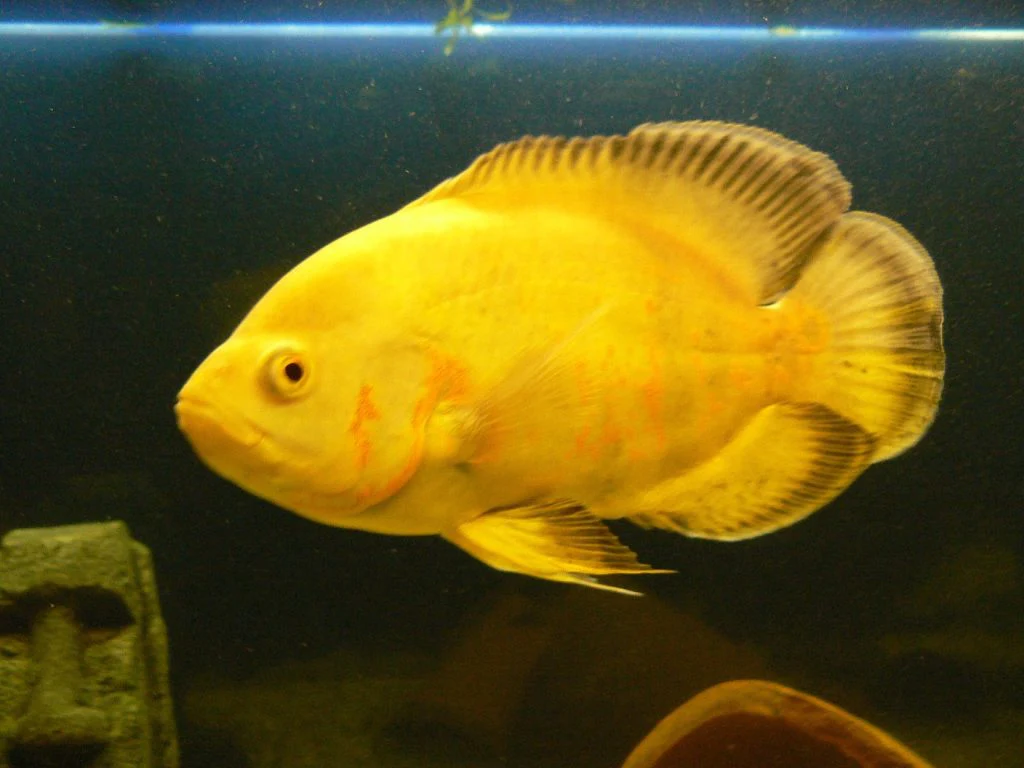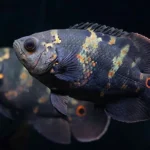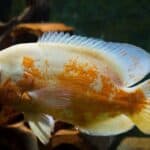Lemon Oscar Fish are a vibrant and captivating variety of Oscars, known for their bright yellow hue and distinctive personality. Originating from the expansive water systems of South America, specifically the Amazon River basin, these freshwater fish have garnered admiration among aquarists worldwide. The Lemon Oscar, scientifically known as Astronotus ocellatus, exhibits a fascinating combination of intelligence and playfulness, which has made them a favorite for those looking to add some liveliness to their aquarium.
Setting up an appropriate home for Lemon Oscars is crucial, as these fish can grow quite large, often reaching up to 12 inches in length. A spacious aquarium that mimics their natural habitat is necessary to ensure their wellbeing. This habitat should include clean, warm water, a filtration system capable of handling the heavy bioload they present, and a diet that satisfies their nutritional requirements. As omnivores, Lemon Oscars demand a varied diet including proteins and vegetables, ensuring they receive all the vital nutrients for a robust health.
Key Takeaways
- Lemon Oscar Fish are a popular aquarium species due to their intelligence and striking color.
- Proper aquarium setup is essential, mimicking their natural environment to accommodate their size.
- A balanced diet and appropriate care lead to a healthy life for Lemon Oscars.
Understanding Lemon Oscar Fish
Lemon Oscar Fish are a vibrant and captivating variety of the Oscar species, known for their unique appearance and interesting behavior. We’ll explore their origin, describe their distinguishing features, and compare them to other types of Oscars.
Origin and Natural Habitat
Lemon Oscar Fish, Astronotus ocellatus, hail from the waters of South America, specifically the Amazon Basin. They’ve also been introduced to other environments, such as Florida. In their natural habitat, they typically inhabit slow-moving rivers and areas with abundant vegetation.
Physical Characteristics and Appearance
These fish exhibit a bright lemon-yellow hue, which can range from pale to vibrant depending on factors like diet and water quality. A mature Lemon Oscar typically reaches up to 12 inches in length and can be recognized by its large, robust body and thick caudal fin. Their unique appearance sets them apart from standard Oscar varieties.
- Body Shape: Oval and laterally compressed
- Coloring: Ranges from pale to bright lemon yellow
- Fin Structure: Large, sturdy dorsal and anal fins with a thick caudal fin
Lemon Oscar vs. Other Oscar Varieties
Lemon Oscars are a variant of Oscar fish and should not be confused with other types like the Tiger Oscar or Albino Oscars. They differ primarily in their coloring and fin patterns.
- Lemon Oscars: Solid or near-solid lemon-yellow coloring with very few markings.
- Tiger Oscars: Dark base covered with orange-red blotches or bands.
- Albino Oscars: White or cream-colored with red eyes; they lack the dark pigmentation typical to Oscars.
The Lemon Oscar Fish’s remarkable color and friendly demeanor have made it a favorite among aquarium enthusiasts looking for a pet with a unique appearance and interactive personality.
Setting Up the Oscar Fish Aquarium
When setting up an Oscar Fish aquarium, it’s imperative to ensure that the tank size, water conditions, and decor meet their unique requirements to promote a healthy environment.
Tank Size and Requirements
Oscar Fish, also known as Lemon Oscar Fish, require spacious aquariums to thrive due to their considerable adult size. An absolute minimum tank size for a single Oscar is 55 gallons, but we often recommend 75 gallons or more for optimal well-being. If housing multiple Oscars, the aquarium size should be increased accordingly, generally adding an additional 30 to 40 gallons for each extra fish. The use of a sturdy stand is also vital, as a filled aquarium can be quite heavy.
Important tank equipment includes:
- Heater: To maintain a warm and stable water temperature.
- Thermometer: To monitor the water temperature accurately.
- Filtration system: To handle the high bioload Oscars produce.
- Lid: Oscars are known to jump, and a secure lid prevents escape.
Water Conditions and Filtration
Maintaining proper water quality is crucial for the health of Oscar Fish. The water temperature should be kept between 74°F and 81°F (23°C-27°C), with a pH level ranging from 6.0 to 8.0. The use of a filtration system is non-negotiable; it helps maintain clean water and removes harmful toxins. A powerful external or canister filter that can turn over the water at least 4 times an hour is ideal, keeping the nitrogen cycle in check.
We should regularly test the following water parameters to ensure they remain at optimal levels:
- Ammonia: 0 ppm
- Nitrite: 0 ppm
- Nitrate: < 20 ppm
Aquarium Decor and Substrate
Oscar Fish appreciate an environment with plenty of hiding places and room to explore. Therefore, we need to incorporate a variety of decorations such as rocks, driftwood, and plants into their habitat. Nonetheless, decorations must be securely placed to prevent tipping, as Oscars can be boisterous.
For substrate, a layer of fine gravel or sand is preferred because it resembles their natural habitat and helps in terms of maintenance. Avoid using small, sharp substrate that could cause injury.
Here’s a brief list outlining the decor and substrate aspects:
- Substrate: Sand or fine gravel, approximately 1-2 inches deep.
- Hiding Places: Caves, large pipes, or rock structures.
- Plants: Sturdy live or artificial plants for cover.
- Lighting: Standard aquarium lighting that provides a day-night cycle without excessive heat.
Behavior and Compatibility
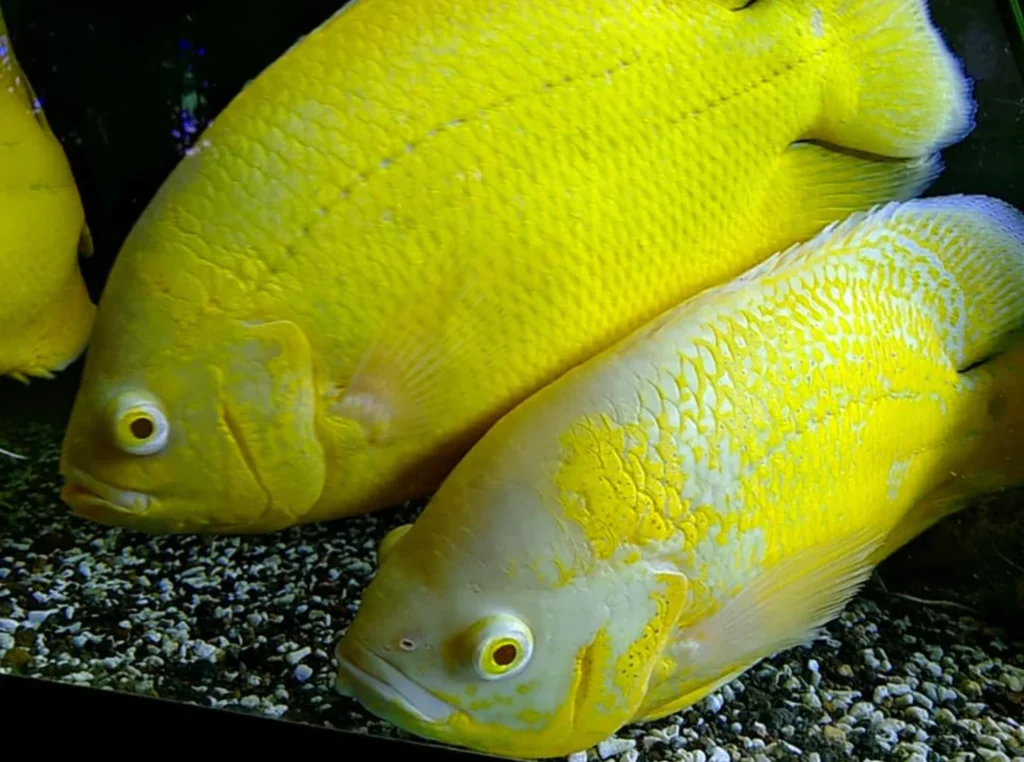
In understanding Lemon Oscar Fish, we recognize their distinct social patterns and how they affect their compatibility with other species in an aquarium setting.
Social Behavior and Aggression
Lemon Oscar Fish typically exhibit a complex and intelligent social behavior. They are known to recognize their owners and can even engage in playful interactions. However, we should be aware that they have a tendency to be territorial and can display aggression, particularly during feeding times or when they feel their space is threatened. It’s not uncommon for Oscars to be aggressive towards smaller fish or even species of similar size if they are introduced into their established territory.
Tank Mates and Community Integration
When integrating Lemon Oscars into a community aquarium, we must be mindful of their temperament. The ideal tank mates are those who can hold their own without provoking additional aggression. Suitable companions often include:
- Large Catfish: These can coexist with Oscars due to their size and peaceful nature.
- Plecos: Known for their armored bodies, Plecos are generally ignored by Oscars, making them a good tank mate option.
It’s recommended to avoid small or overly timid fish, as they can become targets for the Oscar. To minimize aggression in the tank, we ensure the following:
- Sufficient Space: An overly crowded tank can increase stress and territorial behavior.
- Proper Hiding Spots: Providing adequate hiding places can help reduce stress for all aquarium inhabitants.
- Separate Feeding Areas: To prevent competitive aggression, we can establish multiple feeding zones.
By considering these specifics, we can facilitate a more harmonious community aquarium that caters to the Lemon Oscar’s behavioral needs.
Feeding and Nutrition
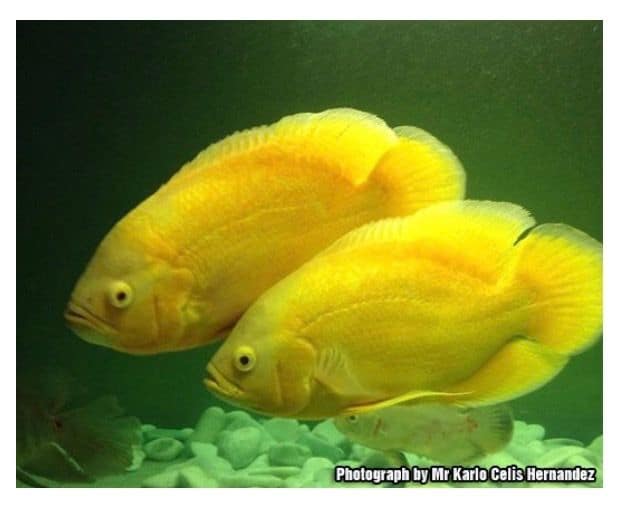
In caring for Lemon Oscar Fish, we must ensure they receive a balanced diet that caters to their omnivorous nature. Proper feeding not only aids in their growth but also in maintaining their vibrant color.
Dietary Needs
Oscar fish thrive on a varied diet that reflects their omnivorous tendencies. The primary elements of their diet should include both meaty foods and vegetables, ensuring they have access to all the necessary nutrients. Our Oscars should regularly be fed:
- Vegetables: Such as zucchini, peas, and leafy greens, providing essential fibers.
- Meaty Foods: Live or frozen foods like bloodworms, brine shrimp, and insects, which are vital for protein.
- High-Quality Pellets: Formulated to meet their nutritional needs, serving as a staple for everyday feeding.
Feeding Strategies and Food Types
Our feeding strategy should always aim to mimic the natural feeding habits of Lemon Oscar Fish. Overfeeding is a common issue that we aim to avoid. Here’s how we can effectively manage their feeding routine:
- Frequency: Feed twice daily, rationing portions that they can consume in two minutes to prevent overfeeding.
- Variety: Alternate between pellets, vegetables, and live foods to provide a broad range of nutrients.
- Live Foods: Occasionally offer brine shrimp or bloodworms to promote active hunting behavior, which is stimulating for them.
By following these guidelines, we can ensure the health and longevity of our Lemon Oscar Fish through proper feeding and nutrition.
Health and Care
Lemon Oscar Fish require meticulous care and attention to remain healthy. We will discuss how to protect them from common diseases and provide maintenance and care tips to ensure they enjoy their full lifespan in your aquarium.
Common Diseases and Parasites
Ich (White Spot Disease): Ichthyophthirius multifiliis, commonly known as ich, manifests as small, white, pinhead-sized spots covering the fish’s skin.
- Treatment: Elevate the water temperature to accelerate the lifecycle of the parasite and add a recommended dose of ich medication.
Hole in the Head Disease: Symptoms include pitting and erosion on the head and face.
- Causes: It’s often attributed to poor water quality and nutritional deficiencies.
- Preventative Measures: Regular water changes and a balanced diet can help prevent this condition.
Maintenance and Care Tips
Water Changes: Perform frequent water changes, around 20% weekly, to maintain optimal water quality.
Temperature and pH:
- Ideal Temperature: Maintain a steady temperature between 74°F and 81°F.
- Optimal pH Level: Keep the pH level around 6.5 to 7.2 for their wellbeing.
Feeding:
- Provide a balanced diet including pellets, live food, and vegetables.
- Growth Rate: Monitor their rapid growth and adjust the diet accordingly.
Tank Size:
- Initial Setup: Start with at least a 55-gallon tank for young Oscars, but as they grow, larger tanks of up to 100 gallons or more may be required to ensure enough space for them to move freely.
By following these guidelines, we can ensure the health and longevity of our Lemon Oscar Fish, providing them with a thriving environment.
Breeding Lemon Oscar Fish
When we look to breed Lemon Oscar Fish, we consider their distinct behaviors and the careful raising of their fry. Our approach ensures healthy development from eggs to juvenile fish.
Breeding Behavior
Lemon Oscars exhibit specific behaviors when ready to breed. We identify a breeding pair when we observe increased territoriality and ritualistic displays. Our fish often select a flat surface and meticulously clean it in preparation for the eggs. We ensure water conditions are optimal, with temperatures around 77 to 80 degrees Fahrenheit, which encourages the breeding process.
Raising Fry
After spawning, the eggs of Lemon Oscar Fish usually hatch within 72 hours. Fry care becomes our immediate focus. We begin by providing the fry with a diet of newly hatched brine shrimp, facilitating their growth. Frequent water changes and a stable, clean environment are crucial—we aim for zero ammonia and nitrite levels to foster the fry’s development. Their growth is monitored closely, noting progress and any necessary adjustments to their care.
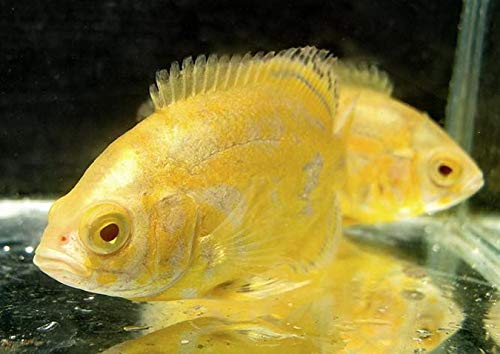
What’s the difference between the Lemon Oscar, the Yellow Oscar, and the Golden Oscar?
The terms “Lemon Oscar” and “Yellow Oscar” typically refer to the same color variant of the Oscar fish (Astronotus ocellatus), characterized by its yellow or golden coloration. These names are used interchangeably in the aquarium trade and do not denote different species or subspecies. The distinction, if any, is usually based on subjective interpretation of the shade of yellow:
- Lemon Oscar: This name might be used to describe Oscars with a lighter, more lemony shade of yellow, perhaps with a more vibrant or bright appearance.
- Yellow Oscar: This term might be used for Oscars with a broader range of yellow shades, potentially including both lighter and darker hues.
However, these distinctions are not standardized and can vary between different breeders, sellers, or enthusiasts. In general, both Lemon Oscars and Yellow Oscars belong to the same selectively bred color variant of the Oscar fish, and any differences in naming are typically more about descriptive preference rather than biological or genetic differences.
The term “Golden Oscar” is yet another name used to describe a color variant of the Oscar fish (Astronotus ocellatus), similar to the Lemon and Yellow Oscars. This naming variation is also based on the fish’s coloration, which in this case is described as golden. Just like Lemon and Yellow Oscars, Golden Oscars are a result of selective breeding for specific color traits within the Oscar fish species.
In the aquarium trade, these names – Golden, Lemon, Yellow – are often used interchangeably and are more about descriptive preference rather than denoting any significant biological or genetic differences. The exact shade described as “golden” might be perceived as more intense or deeper compared to what one might describe as “lemon” or “yellow,” but this is subjective and can vary.
All these variants are Oscars with a predominant yellow or golden hue, but they share the same care requirements, behavior, and characteristics as other Oscar fish. They are large, intelligent, and require significant tank space, excellent water quality, and a well-balanced diet. The choice between these color variants is typically based on personal preference for the specific hue or intensity of the color.
Frequently Asked Questions
In this section, we’ll address common queries regarding Lemon Oscar Fish, focusing on their basic needs and characteristics to help you understand how to best care for them.
What is the typical size of a Lemon Oscar Fish?
Lemon Oscar Fish generally reach up to 12 inches in length when housed in a suitable environment.
What tank requirements are needed for Lemon Oscar Fish?
They require a large aquarium with at least 55 gallons of water for a single fish to ensure they have enough space to thrive and display natural behaviors.
What is the growth rate of Lemon Oscar Fish until fully grown?
Lemon Oscars grow quickly, and it typically takes them about 10 to 12 months to reach their full size.
How should one care for a Lemon Oscar Fish?
Regular water changes and a varied, high-protein diet are essential for their care. Monitoring water quality is crucial as they are sensitive to poor water conditions.
What range of prices can be expected for Oscar Fish in the market?
Prices for Lemon Oscar Fish can range from $10 to $30, depending on size and where you purchase them.
Are Lemon Oscar Fish aggressive or peaceful in temperament?
Lemon Oscar Fish are known to be territorial and can demonstrate aggressive behavior, especially when kept with tank mates of a similar or smaller size.
